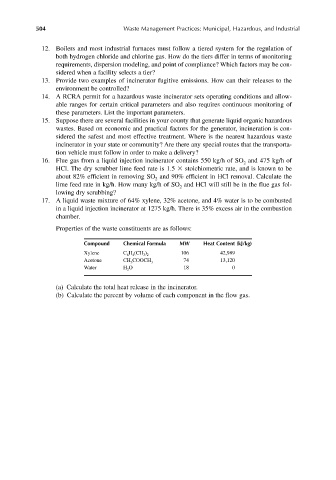Page 533 - Materials Chemistry, Second Edition
P. 533
CAT3525_C15.qxd 1/27/2005 12:40 PM Page 504
504 Waste Management Practices: Municipal, Hazardous, and Industrial
12. Boilers and most industrial furnaces must follow a tiered system for the regulation of
both hydrogen chloride and chlorine gas. How do the tiers differ in terms of monitoring
requirements, dispersion modeling, and point of compliance? Which factors may be con-
sidered when a facility selects a tier?
13. Provide two examples of incinerator fugitive emissions. How can their releases to the
environment be controlled?
14. A RCRA permit for a hazardous waste incinerator sets operating conditions and allow-
able ranges for certain critical parameters and also requires continuous monitoring of
these parameters. List the important parameters.
15. Suppose there are several facilities in your county that generate liquid organic hazardous
wastes. Based on economic and practical factors for the generator, incineration is con-
sidered the safest and most effective treatment. Where is the nearest hazardous waste
incinerator in your state or community? Are there any special routes that the transporta-
tion vehicle must follow in order to make a delivery?
16. Flue gas from a liquid injection incinerator contains 550 kg/h of SO and 475 kg/h of
2
HCl. The dry scrubber lime feed rate is 1.5 stoichiometric rate, and is known to be
about 82% efficient in removing SO and 90% efficient in HCl removal. Calculate the
2
lime feed rate in kg/h. How many kg/h of SO and HCl will still be in the flue gas fol-
2
lowing dry scrubbing?
17. A liquid waste mixture of 64% xylene, 32% acetone, and 4% water is to be combusted
in a liquid injection incinerator at 1275 kg/h. There is 35% excess air in the combustion
chamber.
Properties of the waste constituents are as follows:
Compound Chemical Formula MW Heat Content (kJ/kg)
Xylene C H (CH ) 106 42,989
4
6
3 2
Acetone CH COOCH 3 74 13,120
3
Water H O 18 0
2
(a) Calculate the total heat release in the incinerator.
(b) Calculate the percent by volume of each component in the flow gas.

